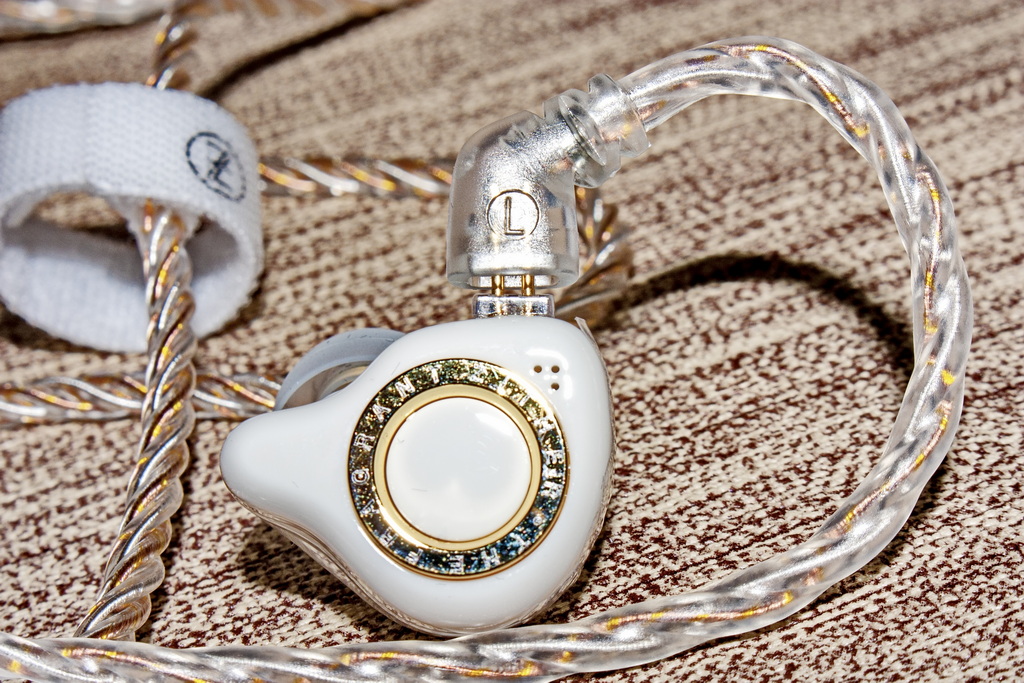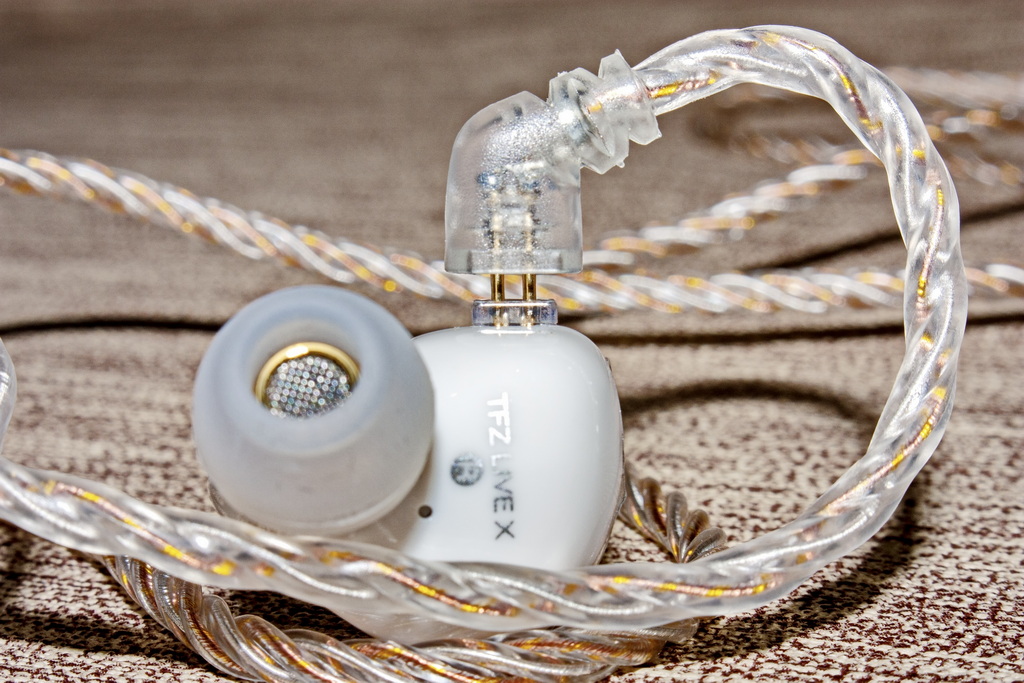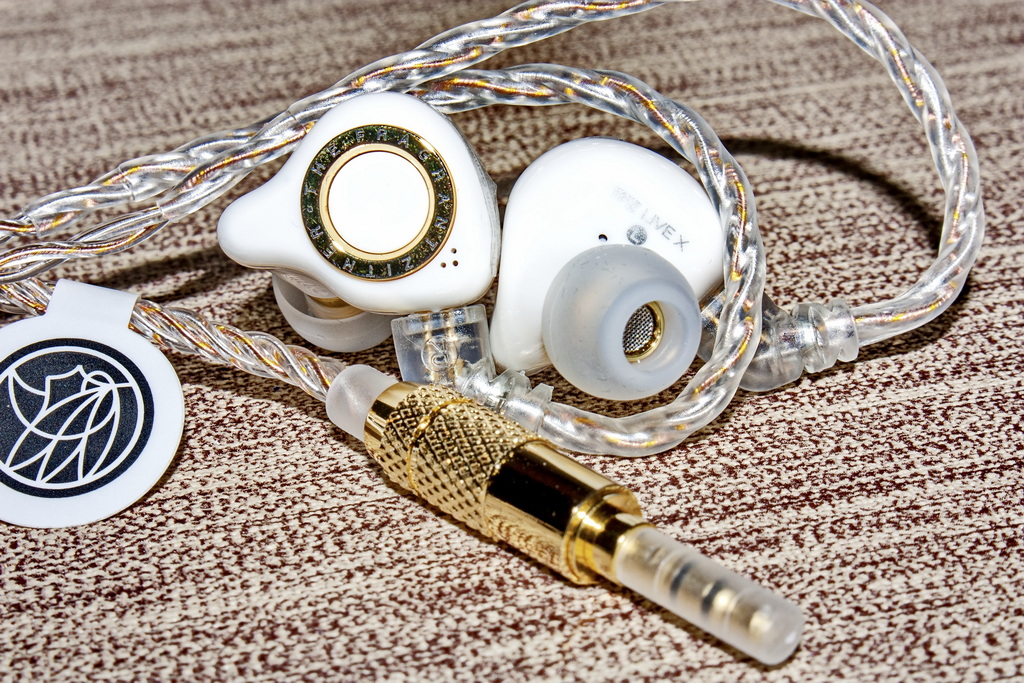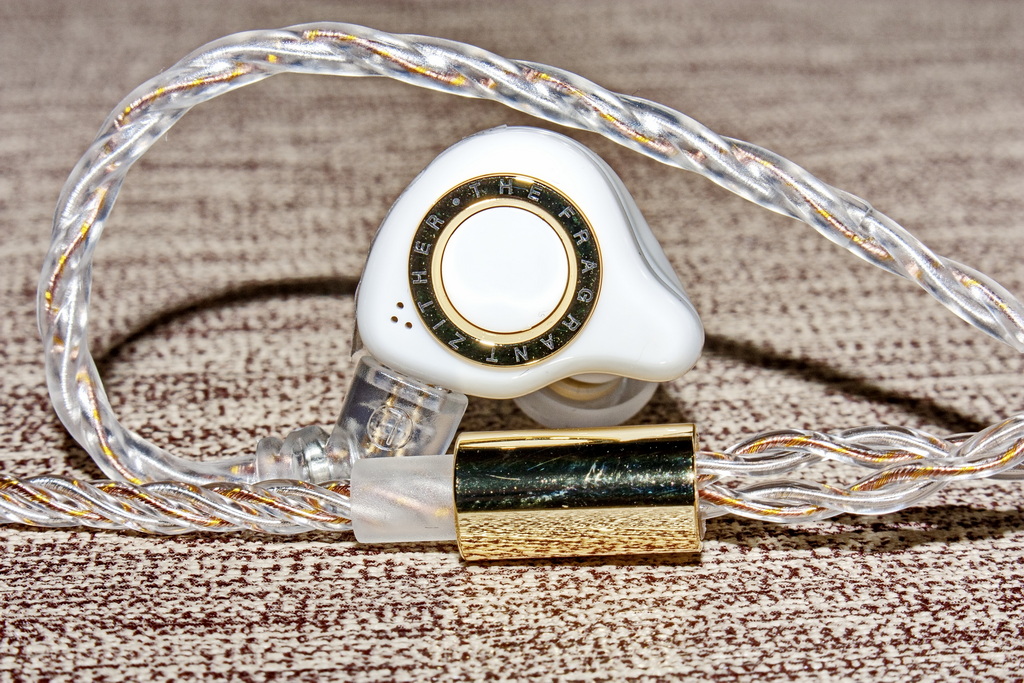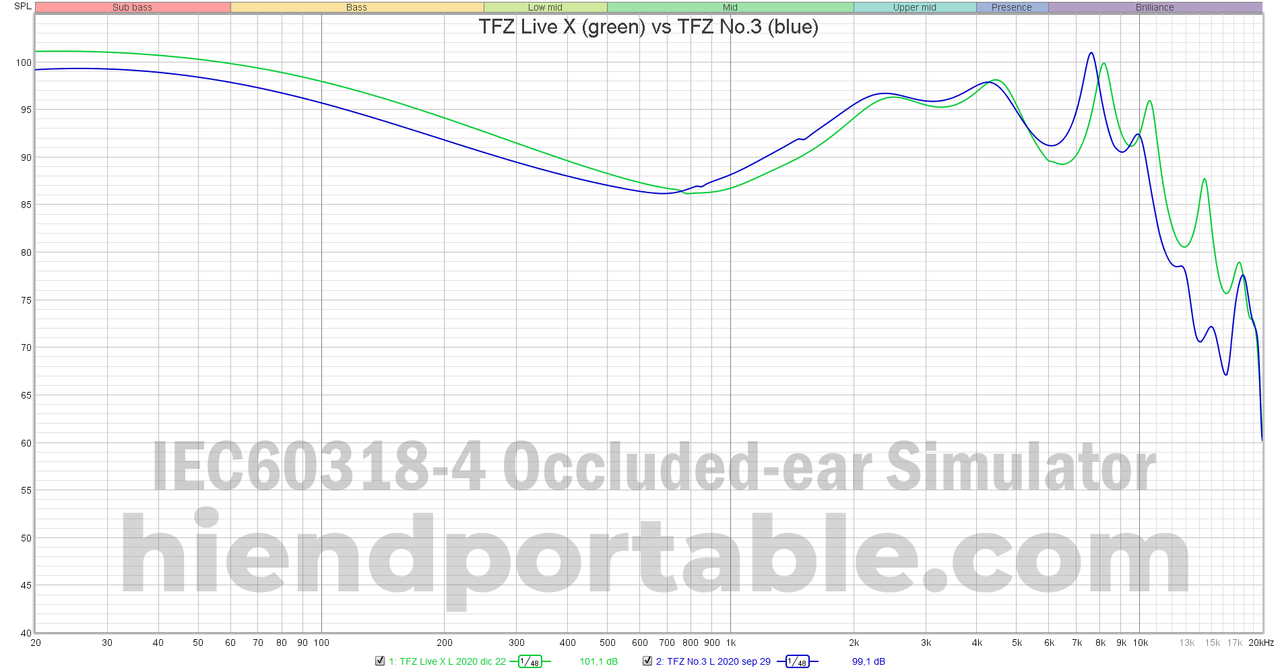Introduction
TFZ multiplies its bet by 10 and brings out the X model from its Live series. After models 1 and 3, of course, there are ten. And to reach the excellence nothing less than gold: the one used in its diaphragm for the first time. The Shenzen brand accompanies its 4-generation driver with a sprayed diaphragm with an even, dense nano-gold coating for an extraordinary hearing experience. That's what the description of this new model says, and not only that. The dual-circuit magnetic acoustic design, capable of providing more than 1 Tesla flux, has been enhanced to optimize distortion, enhance detail, expand dynamics, and help all frequencies increase their level of clarity. The high-precision moulded acoustic cavity, associated with a concise manufacturing process, ensures the elimination of resonance, to produce a stable and realistic timbre.
As can be seen, manufacturers do not skimp on diverse and varied technologies, with the best intention of offering the best sound at the lowest price. It is these latter terms that we fans understand best. As usual, I will now try to decipher what lies behind TFZ's good intentions, for this new model, whose starting price is close to $200

 Disclaimer
Disclaimer
Penon Audio Store, offered me this model, in exchange for writing an honest review. I want to make it clear that all my opinions written in this review have not been conditioned by this fact, nor will I ever write anything that I do not really think or feel here. I will only write about my personal opinion in relation to the revised product.

 Purchase Link
https://penonaudio.com/tfz-live-x.html
Purchase Link
https://penonaudio.com/tfz-live-x.html

 Specifications
Specifications
Driver type: Dynamic 11.4mm double magnetic circuit, 4 generation Tesla, double cavity, with gold sprayed diaphragm.
Frequency Response: 5Hz-40kHz
- Sensitivity: 105dB/mw
- Impedance: 25 Ω
- Cable length: 1.2m
- Minimum power: 8mW
- Jack connector: 3.5mm Single Ended.
- Capsule Connection Type: 2 pin 0.78mm

 Packaging
Packaging
It's curious, but the packaging of the new TFZ Live X reminds me of a luxurious box of chocolates... Its large square dimensions (237x237x36mm), its narrow thickness, the satin black texture and the large gold letters and frames of the same colour, lead me to that feeling. The box is very elegant, with all the edges of dark gold on a black background, with a millimetric texture. Apart from this, very few elements: The name of the model in big golden letters, with a slight relief. At the base and at the top, the phrase "IN EAR MONITOR", following the same golden tone and its relief. On the sides, the TFZ logo, using the same engraving technique. On the back, the letters are still gilded and in capital letters, but no longer in relief. In the upper left corner you can read the name of the brand, the address of its location (in English and Chinese) and the web address. In the lower left-hand corner, a sticker describing the colour chosen, from 6 different models: white, black, green, pale pink, light brown and light grey. More or less, that's what my manly eyes allow me to distinguish. In the other lower corner there is a sticker with a QR code and the seal of authenticity. Finally, below is the code EAN13.
After removing the cover few elements can be seen: the white capsules with their connected cable, embedded in a dark and dense black and shiny foam mould. A piece with the brand logo, a smaller box, similar to the exterior and a foam cover with a fabric ribbon, under which is the rest of the cable. In the other box are the rest of the accessories. In short:
- The two Live X capsules.
- The 2 Pin 0.78mm cable.
- 1 blister pack with 3 pairs of translucent white silicone tips, narrow channel, sizes SxMxL.
- 1 blister pack with 3 pairs of wide channel translucent white silicone tips, sizes SxMxL.
- 1 pair of wide channel translucent white silicone tips, size M, already in the IEMS.
- One pair of tweezers.
- One user guide.
The box is really big and beautiful, but its size predicted a greater number of accessories. However, although silicone tip sets are adequate, I miss foam tips and, above all, a case to store the IEMS. What happened to the big box of Tequila? Also, for the price, you could have included some balanced solution, so popular in recent times. On the other hand, the quality of the cable does seem to be in line with the price, without being excellent, it doesn't seem necessary to change it for another one, unless you don't like the striking gold of its connector and its large dividing piece.

 Construction and Design
Construction and Design
The TFZ Live X looks like an ode to gold, golden nozzles, golden outer rings, golden wire strands, golden connectors... even the splitter is in this colour. And what about its diaphragm, which has even been sprayed with a uniform nano-gold coating. Congratulations to those who like this precious metal. The rest, like me, will find it a bit excessive. Luckily, the capsules are bright white. Made of smooth and hard resin, with a thick but rounded body, these capsules have that external silhouette of the African continent, with nooks and crannies and subtle valleys that emphasise their beauty, ergonomics and comfort. Quite lightweight, they have a golden ring embedded in their external face. Engraved on it, the name of the brand. Three small holes are located in one of the corners, very close to the two-pin connector. TFZ mounts its classic connection method, which consists of a square plate made of transparent plastic, with rounded corners, superimposed on the upper edge of the capsules. Two holes with gold-plated sleeves are equidistant on the inside. It can be seen that the capsule is made up of two joined faces, although the separation is sealed in an excellent way, with hardly any space or separation to be seen. The entire body of the capsule is smooth and very rounded, without any protrusions. The name of the model can be read on the inner side, as well as the channel, written in silver ink. There is another hole nearby, located between the channel mark and the side of the nozzles. As I said before, these are a different piece, metallic and gilded. Its total length is about 6mm and its shape is slightly conical, but with a central ring of clearly lower diameter. The base measures almost 3mm, with a diameter of more than 7mm, the central ring measures 1.5mm with a diameter of 4.75mm. Finally, the outer crown shares length with the central part, but its diameter is decreasing, starting at 6.1mm from its base. At the tip, a thick, non-golden metal grid protects the inside of the IEMS.
There is no denying that the capsules are bulky, which is obvious when they are worn. But this does not imply a high weight.
The cable consists of four strands wound together, covered with transparent plastic. One pair of strands is silvered and the other two have a subtle gold coating that turns to copper. The plug is 3.5mm single-ended, covered by a large, classic gold-plated, cylindrical sheath, with two thick rings with a very marked texture. The splitter is a smooth metal and gold cylinder. The cable does not have an adjustment pin, but it does have a velcro strip to hold it, a cover for the connector and the classic white paper ring with the brand logo, surrounding the cable, at its closest point to the jack. Near the two-pin connection, semi hidden in its pool, are the guides over the ear. Luckily, they do not have a stiffness that can disturb you.
More or less classic design, emphasized by its golden parts and its large matching outer ring. The colour can be chosen from the various options already mentioned, which is always a good option. The materials used seem to be of very good quality and it does not seem that gold is susceptible to lose its colour. Pleasant capsule design, yet robust and durable. The attachment of the metal nozzles to the body seems to have no weak points and feels well anchored.
The cable, on this occasion, seems to have been chosen more carefully and is more in line with the price and quality expected, without it reaching excellence, fulfilling its role more than correctly.

 Adjustment and Ergonomics
Adjustment and Ergonomics
Despite the thickness of the capsules, thanks to the good length of the nozzles, their faces barely touch the edges of the ear. The adjustment can be from shallow to medium, depending on the tips chosen and the width of our channel. It should be remembered that the nozzles on its outermost ring measure 6mm, which can limit insertion. In my case the Live X allows me to alternate between several types of tips, with which I can vary from superficial to medium insertion, achieving different levels of immersion and isolation. Together with the great sensitivity of these IEMS and their truly powerful sound, it is very easy to achieve a remarkable level of tightness.
The insertion is simple and durable, with hardly any rotation of the capsules once fitted. There is no feeling of detachment and the coupling is durable with the right tips, being suitable for use in movement, or even for running.

 Sound
Sound
Profile
TFZ has tuned the Live X with a classic curve to its credit, reminiscent of its successful No.3 model. Its profile is in U-V, with a more powerful sub-bass and a high-mids less marked by the brightness, offering more smoothness in this area, but without losing an ounce of clarity or cleanliness, adding a greater amount of air.

 Bass
Bass
TFZ continues to be true to its philosophy and this means that it is impossible to remain indifferent to the lower range of its models. On this occasion, this premise is maintained, even redoubling the bet. The Live X will be adored by the Bass-Lovers. And I, as one of them, can only enjoy them. In case you have any doubts, with the first few compasses, any hint of doubt disappears. The Live X's continue to exemplify that TFZ is still committed to a huge low zone, focused on a very deep sub-bass and a very physical beat, which is projected from the lowest frequencies. The "bass kick" performed by the Live X is maintained up to 10 Hz, with hardly any loss of strength and power. In this way, their power remains intact throughout the lower range. From then on, as is usually the case with U-profiles, the lower area relaxes, preventing the mid-bass from feeling bloated or boomy But what TFZ has achieved with this model is a huge relationship between the sub-bass's very physical and powerful body and its speed. It is surprising how such a powerful hit recovers so quickly. So much so, that its power truly stuns. But its fast recovery makes the sub-bass notes enjoy a very high precision, drawing them compact, defined, very complete and perfectly finished. Its edges are quite smooth, its roughness is low, giving rise to very rounded basses, but very full in its deepest part, with a clearly palpable body, coming to offer a very physical sensation, demonstrating that they are capable of moving a good amount of air at high speed, within our auditory channels. This is a pleasure, but also a warning: Live X's can be very attractive because of their lower zone, but this enormous power and the physicality of their lower zone can be very dizzying.
The fact that the bass feel smooth and compact shows them to be very elegant, but they lose some richness in their expression, diminishing their descriptive power and presenting themselves in a simpler way. The Live X's are more focused on the grandeur of their lower zone, than on the recreation capacity of their textures or their different planes. Although this fact does not make the tonality, nor the timbre, nor the realism suffer, but it does introduce a slight colour in its reproduction.

 Mids
Mids
Each model that TFZ puts on the market, supposes a turn of the screw in the relation of the low zone, with respect to the mids. It seems as if their commitment is to recreate some bass explosives, without the central range feeling compromised and this can be perceived as an individual part, without interference. This is no less commendable, but it is really complicated. Although they are becoming wiser and their central zone benefits from this.
Even so, in TFZ they continue to opt for a profile that tries to move the first half of the central rank away, emancipating the upper mid-range. The bass will always sound in the foreground, but their respect for the middle is totally evident in this new model. It is very easy to mentally distinguish the powerful bass section from the instruments and voices of a song. The planes here are very well defined and separated. There is distance between them, but no mixing. Even overlapping is avoided with diligence and grace.
The timbre is presented quite realistically and neutrally, there is not much warmth, nor coldness, nor is it blatantly natural, nor is it analogical. It does not really stand out, but the good work of integration between the bass and treble is appreciated, achieving a remarkable balance, which does not lean towards either brilliance or warmth. The same goes for resolution, their profile is not analytical, nor are they too soft, but they have a great relationship between both worlds, without this mixture being blatant or forced.
Returning to the mids itself, its approach is characterised by the smoothness of its reproduction, clarity, cleanliness and, again, neutrality. The range is somewhat dry, not very juicy, with a good quota of delicacy and an average descriptive level, which does not deepen either in its texture or in expressing a more organic, raw, vivid or complex recreation. It is not an emotionless midrange, but the sensation that they give off, compared to the physical of their lower area, is that they do not have that differential treatment, which gives them a more palpable life, details that provide greater complexity, substance and flavour. In this way the mids suffer from the corporeal magnitude of the lows, feeling somewhat dwarfed, less present and secondary.
The voices, appreciated in their warm distance, manage to sound quite homogeneous, with a very natural timbre, balanced, clear and clean. Their relative distance aligns them very much to the instruments, sharing, smoothness, limited descriptive capacity, tonality and level of expressiveness. It cannot be said that they distil emotion, although their fidelity is good, without being able to be crossed off as brilliant or lacking in body. But, really, they do not stand out in texture nor in their inherent details, although they do excel in their musicality and a good dynamic level.
On the other hand, I think that the elevation of the upper mids is really well achieved. Live X's never feel shrill, or forcefully bright, but are able to retain their neutrality, without the risk of sibilance, unnatural effects or fatigue. In this sense, this tuning achieves exactly what it was intended to do: bring a lot of clarity and cleanliness to the sound, while maintaining a realistic timbre and a homogeneous and balanced tone.

 Treble
Treble
The treble of the Live X is a true paradigm of successful tuning. TFZ has achieved an enormous naturalness and harmony with the neutrality of the sound of the rest of the ranges, but without losing an ounce of eloquence, vivacity, realism, sparkle and definition in their treble. The relationship between the level of energy, detail, emphasis, sonority and naturalness is excellent. The most critical passages are reproduced with undoubted elegance and simplicity, but without the need to hide or smooth out the range. In this way, the high band can be fully enjoyed, both in definition and resolution, level of detail, even extension and amount of air.
I cannot say that the high notes are crunchy, because this adjective is not capable of defining them exactly, since, in my opinion, it takes them away from reality. And this is that the last range is really enjoyable, even in long listenings, there is no risk of saturation, nor of undesirable peaks.
I would like to stress that the Live X's are not analytical, despite the high level of their highs. And therein lies their excellence in this respect: the ability to provide a very faithful and natural sonority, clearly distinguishable and precise, without falling into the over-excitement of range, nor the extreme narrowness and excessive finesse of their high notes. Both its height and width are adequate and in accordance, respecting the homogeneity of the sound and the integration with the rest of the bands. Little more can be asked in this respect.

 Soundstage, Separation
Soundstage, Separation
In my humble opinion, the scene has never been a strong point in the TFZ IEMS, which I have had the pleasure of evaluating. But, in this case, this section is also on the path to improvement. It is not a drastic improvement, but it is true that the size has increased. In this sense, the scene is quite round, with a quite clear and perceptible semi-spherical sensation, where the notable separation and the good work of the high area, are capable of locating the elements with the necessary precision to determine a very concrete and concise spatial positioning. The level of detail remains within the framework that has been broken down in this review: realistic and natural. The resolution of the high area enables its definition in a very coherent and musical way. In this way, the nuances are presented with ease and without artifice, revealing themselves effortlessly, but without reaching a level of analytical neatness, which deviates from the aforementioned path of naturalness.
The separation is easily perceived and is the real culprit of the remarkable distinction between bands that Live X's possess, allowing the powerful bass notes, the delicate mid notes and the precise treble notes to be individualized. This is how the distance is distributed in a very coherent way, without reaching an abyssal darkness between the elements, but maintaining a great capacity to distribute the sound throughout the stage, without any effort. It is in this way that the small nuances appear carelessly, in a simple and light way, as if they had always been there... Although not all IEMS are capable of reaching this point and even less so, so full of faculties.

 Comparisons
Comparisons
ISN H40
At almost the same price, the ISN H40 has been one of the highest rated IEMS in the past year, although it came out in late 2019, in its price range it is still a true benchmark. With a warmer, but also more balanced profile, they have a more equilibrated and less polarised bass-midrange ratio than the Live X. The capsule of the ISN is a bit more custom and its shape fits my ears more firmly than the TFZ. Although the Live X has a deeper insert which can be more versatile when choosing tips. Their cable, of course, coming from ISN, is excellent, but it's a pity that their connection is MMCX, I find the 2-pin connection less problematic and durable. The cable of the Live X is thinner, has 4 strands, compared to 8 of the H40. Moreover, it is mixed, while in the ISN all its wires are silver plated.
Entering the sound comparisons and starting from the bass zone, both contenders are great rivals. Qualitatively speaking, I find the lower zone of the H40 fantastic, with a descriptive texture, above the Live X in this sense. But the TFZs have a more physical and forceful capability. The difference in both aspects is not extremely high and the lower zone looks more like it than I thought it would. On the other hand, there are more differences in the timbre than in their performance. Thus, the Live X, worth the redundancy, are more vivid, cleaner and clearer. H40s are a little darker, which can give a feeling of greater depth. But going back to the timbre, I prefer the more realistic and natural approach of the Live X, even though I miss the greater presence and closeness of the mid-range of the ISN.
Continuing with the mid-range, in this area the differences are somewhat greater. Starting with the presence level, the ISNs are clearly closer and closer, but with a slightly less accurate timbre than the Live Xs, darker, with a slight nasal/muddy sensation, comparatively speaking. TFZs are lighter, more natural, but more delicate and delayed. The voices are very soft, but smooth. There is more emotion and texture in the H40, plus a higher level of transparency, separation and definition, the result of its more analytical, precise and resolving BA driver. The closeness of these aspects also plays a role, but I think that technically, the ISN's midrange is somewhat superior to the TFZ. Their notes in this range are finer and move in a wider and more separate space, with a darker background and more perceptible distance. Thus, details, nuances and textures are more visible, something that in the Live X is not so simple, due to the greater musicality and distance, which gives it a more homogeneous and cohesive flow, showing more sweetness and that characteristic naturalness.
The treble is the most distinct range, in terms of presence, between the two IEMS and possibly the reason for choosing one or the other. Although the H40 has 2BA composites for the high frequencies, this range cannot be said to be very marked, but is clearly in line with its profile. In contrast, in the Live X their exposure is clear but with excellent control. Treble is more prevalent in the TFZ sound than in the ISN, but without a hint of negativity. On the contrary, in my opinion, everything adds up in the high range of the Live X. Actually, in the ISN, the treble is quite good, simply its presence and incidence in the sound is lower, although not its quality. There is a slightly different pitch in the initial part, something that allows the first treble to be more prominent in the Live X. But, beyond those terms of presence, I don't see a difference in the execution of the high notes. In both there is good resolution and very good level of detail, as well as an excellent amount of air. The difference lies in a different pitch in this range.
The ISN stand out for having a fairly wide scene, with very good separation, distinction between notes and amount of air. Its background is darker than in the Live X, something that can be seen in the middle zone, where the elements are perceived more separated and can be individualized more easily. The distance in this range, in the Live X's and their greater cohesion in the sound, makes them more musical, but less analytical. And in this sense, the separation suffers a little from the greater transparency of the H40. However, the level of detail is very good in the Live X, being superior in some aspects to the ISN. The greater vividness of its sound and the feeling of its simple, but excellent execution, gives this advantage in some musical passages.
In short, comparing these two great beasts at around $200 has been a real pleasure and enjoyment. In addition, my opinion of the TFZ Live X has been greatly enhanced by the fact that it is almost on a par with the fantastic ISN H40 and in some respects even superior.
 TFZ My Love III
TFZ My Love III
Somewhat lower in price, TFZ has many other models, but I wanted to choose the My Love III and check whether the price difference between the two is justified. On a construction level the Live X seems more robust and a little heavier; its capsule is a little bigger and is more rounded, they don't have the semi custom shape of the My Love III. The cable is clearly superior in the Live X, which is totally appreciated. The My Love III uses a second generation 9mm driver, while the Live X uses a fourth generation 11.4mm driver. The diaphragm is nano graphite in the My Love III, while the new model is gold-powdered.
The new model, specifications apart, moves more easily, providing a more forceful sound in the first instance. The profile is slightly more pronounced in V, in the My Love III. In addition, they have a slightly more relaxed and analogue sound.
The lower zone of the Live X is more forceful, deep, physical and powerful. You can see how the new model has gained in energy and sound pressure, sounding more thunderous and bigger. Even the precision is better, sounding more defined and with more recovery, something that seems incredible, given the amount of power of the Live X. The texture of the Live X is more sensitive, achieving more detail and a higher level of complexity when playing the bass.
In the middle zone, the reduced presence of the bass in the My Love III brings the range slightly closer to the listener. The timbre is very similar in both models, being a little bit brighter, something that can be observed in the female voices. However, the definition of the voices, their level of precision and resolution capacity, is superior in the Live X. There is more clarity and transparency in them, so it is easier to isolate them from the rest of the elements and, in turn, be able to detect more details and nuances. It seems clear that the new driver manages to be more analytical and powerful, but it also improves the high range, making it more exciting and present, with more extension and brilliance. It is in this range that the Live X's demonstrate their true potential in the face of the My Love III's, proving to be superior, but without sacrificing their finesse, or sounding shrill. Where the My Love III is safe, the Live X's are explicit and expressive, without fear of being wrong. And all this helps to make the level of separation, spatiality, positioning, separation, instrumental location and scene width, better in the Live X's.
If the My Love III was already good, the Live X goes a step further, improving not only each range, but also in technical characteristics.
Conclusion
TFZ continues to redefine low zone reproduction in a surprising way, adding more power, but without losing the relationship with the rest of the sound ranges. The basses are not only more physical and powerful, but also have a remarkable speed and elasticity, without losing detail or realism, combining a totally overwhelming forcefulness. And, in spite of them, the middle range sounds delicate, precise, musical, clean, transparent, clear, with a very natural and realistic timbre. And what can we say about its treble, where the evolution of its driver has given the Live X a surprisingly high zone, for being so complete and explicit, executed in a way that seems so simple and straightforward, without offering a hint of stridency, just naturalness and detail. In this way, TFZ continues in its quest to offer the best bass, but with the intention of attracting bass lovers to more audiophile terrain, since both the mids and highs are improved in the same proportion ... Or even more.

Sources Used During the Analysis
- Earmen Sparrow.
- Earmen TR-Amp.
- E1DA #9038D.
- Burson Audio Playmate.
- HiBy R3 Pro.
Ratings
- Construction and Design: 85
- Adjustment/Ergonomics: 86
- Accessories: 60
- Bass: 91
- Mids: 80
- Treble: 90
- Separation: 87
- Soundstage: 88
- Quality/Price: 89
You can read the full review in Spanish here
































